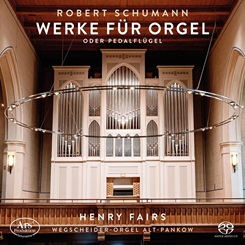« Offen gesagt, ich lege einiges Gewicht auf die Idee, und glaube, dass sie mit der Zeit einen neuen Schwung in die Claviermusik bringen könnte. Ganz wundervolle Effecte lassen sich damit machen », schreibt Robert Schumann in einem Brief an seinen Verleger. Die Sache mit dem neuen Schwung hatte sich allerdings schnell erledigt. Ein Klavier, kombiniert mit einem Orgelpedal, verfehlte als Neuerung nicht seine Anziehungskraft und inspirierte etwa Robert Schumann zu einigen Kompositionen, die Henry Fairs jetzt auf der Orgel eingespielt hat.
Der Wechsel zur Orgel ist nur selbstverständlich, denn die Schumanns hatten sich das Pedalklavier zum Üben des Orgelspiels angeschafft.
Von reinen Übungsstücken ist bei Henry Fairs jedoch nichts zu spüren. Kein rein mechanisches Spiel, keine kühle technische Lektüre. Der britische Organist belebt die kurzen Genrestücke durch stilsicheres und facettenreiches Gestaltungsvermögen. Besonders die sechs Fugen über B-A-C-H entzieht er derart ihrem strengen formalen Korsett und belebt sie, ebenso wie die Studien und die Skizzen, mit feiner Dynamik und vielfältigen, kontrastreichen Klangfarben.
« Frankly, I attach a great deal of importance to the idea and believe that in time it could bring a new impetus to piano music. Quite wonderful effects can be achieved with it, » wrote Robert Schumann in a letter to his publisher. However, the matter of the new impetus soon came to an end. A piano, combined with an organ pedal, did not fail to attract attention as an innovation and inspired Robert Schumann, for example, to write several compositions that Henry Fairs has now recorded on the organ. The switch to the organ is only natural, as the Schumanns had acquired the pedal piano to practise playing the organ.
However, there is no sign of pure practice pieces with Henry Fairs. No purely mechanical playing, no cool technical reading. The British organist enlivens the short genre pieces with his stylistically confident and multi-faceted creative ability. In particular, he frees the six fugues on B-A-C-H from their strict formal corset and enlivens them, as well as the studies and sketches, with fine dynamics and diverse, contrasting tone colors.




















